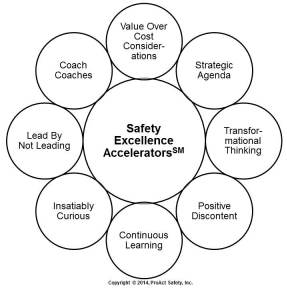Becoming a Rising Star in Safety
Anyone can be an effective leader if provided the right focus, skills, tools, and support.
Safety professionals will play many roles throughout their career. Some will be cops, some coaches, and others will primarily be trainers and facilitators. Some will focus exclusively on compliance, others will evolve their organizations from compliance to culturally focused. Many will retire after long careers within corporations; some, like me, become consultants. But some of the most impactful individuals in safety performance and culture aren’t even safety professionals.
These individuals are the workers who take an interest and receive safety magazines at home, looking for ideas. They are the supervisors who believe there has to be a better way for their people or the senior executives who feel safety can be better and recognize they are the ones who need to take the lead. Those who help transform performance and culture are the individuals who truly shine in safety and should be recognized and invested in.
One organization that recognizes these individuals is the National Safety Council (NSC), which is celebrating 40 individuals who make up its list of Rising Stars at this month's annual conference.1 According to some of the criteria, a Rising Star is someone who "demonstrated safety leadership, with practical examples of:
- Leadership attributes that set the nominee apart from his or her peers
- Initiating and/or leading a successful safety initiative with measurable results
- Engaging peers and transforming the safety culture of the organization
- Valuing safety as a critical part of business operations."
 Anyone can be an effective leader if provided the right focus, skills, tools, and support, so the goal of this article is to provide insight in to how the most effective leaders enable cultures of safety excellence.
Anyone can be an effective leader if provided the right focus, skills, tools, and support, so the goal of this article is to provide insight in to how the most effective leaders enable cultures of safety excellence.
Through many years of research and coaching safety leaders of all levels and areas, eight accelerators to safety excellence have been identified (see the figure, Safety Excellence AcceleratorsSM). These accelerators have been leveraged to directly contribute to an improvement in the leader’s influence and overall effectiveness in capturing new results. They outline how the leaders who consistently outperform others think and behave.
1. Value Over Cost Considerations. Safety is viewed through a value-add lens. Costs are important but are not the primary answer to the "Why are we doing this?" question. "Does this add value and improve the lives of the employees?" is the driving question.
2. Strategic Agenda. Safety decisions are proactively prioritized, leveraging data to identify objectives and initiatives that measurements will validate directly contributed to improvement. The strategy is not a program or a Zero Injury Goal. Safety is managed like a business division.
3. Transformational Thinking. Continuous improvement is driven through efficiency and effectiveness, and choices are made that satisfy the transformational question, "What one thing could we do here that would make the biggest difference?"
4. Positive Discontent. Similar to better vs. best practices, we realize we will never be excellent in safety for there are always thing we will know tomorrow that we do not know today. We will never be complacent and while we will celebrate success, we will strive for continuous improvement because we maintain a healthy sense of vulnerability in safety.
5. Continuous Learning. We believe investment in personal growth yields both personal and organizational value. We also realize there is more than we could ever know but are transformational in our search for new information, ideas, or practices that could help us help others deliver new value in safety.
6. Insatiably Curious. A respectful, questioning attitude dominates thinking and interactions. As we improve, we realize even the best strategies can go awry because we are human and can make mistakes. We seek to gain insight and understanding rather than haphazardly offer advice or place blame. We help transfer this attitude throughout the culture to facilitate organizational learning.
7. Lead By Not Leading. We develop others and create the desire to volunteer and never voluntold people. We do this by developing teams that are successful, and everyone knows it! We realize our team needs us more than we need the team, culture change happens best from within, and improvement ideas are best owned by those who originated them.
8. Coach Coaches. We develop coaches throughout the organization to help everyone focus on the most important items, provide feedback that shapes future decisions and behaviors, and facilitate by addressing the areas that make it difficult for people to perform their tasks risk-free. Further, we coach these coaches to help everyone continuously improve and create a culture that evolves the organization from a focus on results to enablers of desirable performance because, after all, we can always be better.
These eight accelerators are routinely used in consulting work to facilitate the executive’s ability to improve the organization's strategy, leadership, culture, and performance in safety. Last year, I was honored to be named along with 39 other individuals to the 2013 Class of NSC Rising Stars of Safety. I will be presenting at the 2014 conference on what it takes to become a Rising Star in Safety. I hope to see you there and among next year's list.
Reference
http://www.nsc.org/safety_work/NSCAwards/Pages/RisingStarsofSafety.aspx#.U1212PldWSo
This article originally appeared in the September 2014 issue of Occupational Health & Safety.